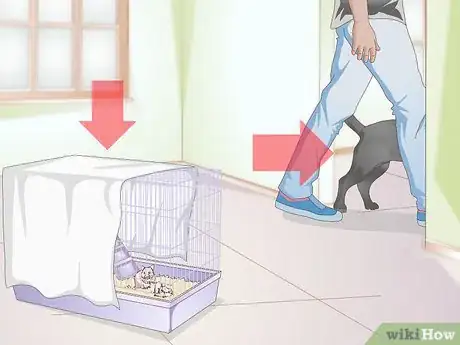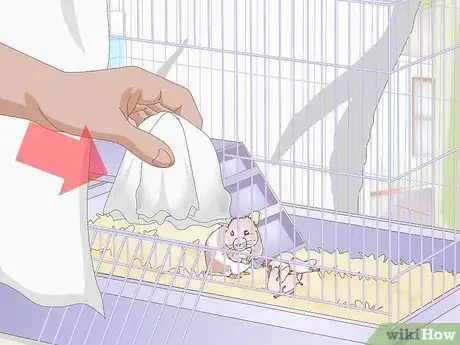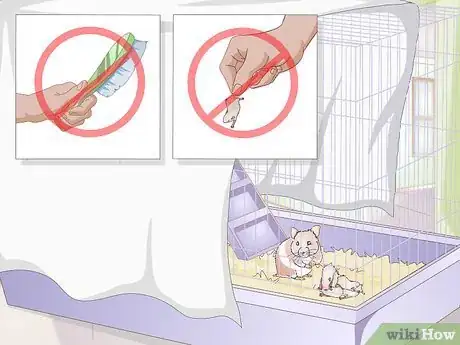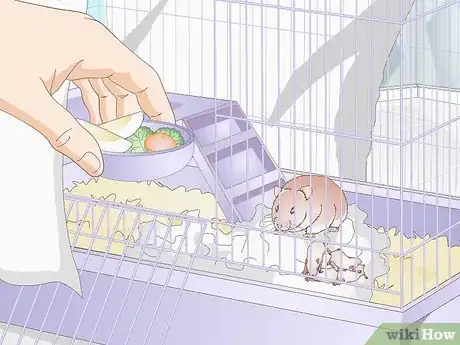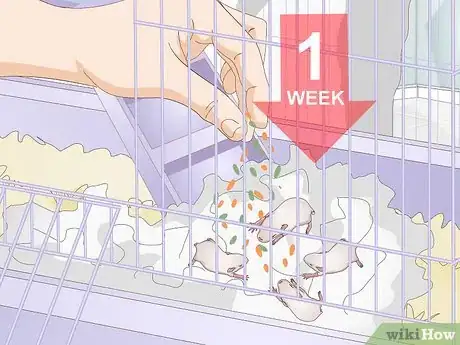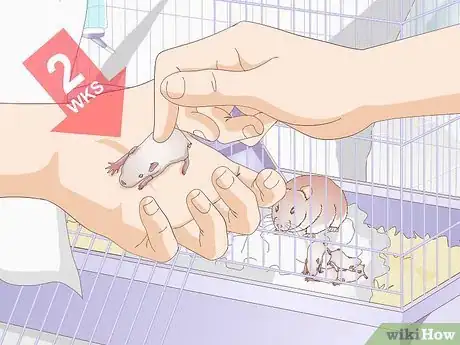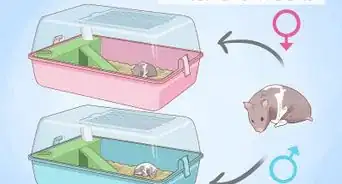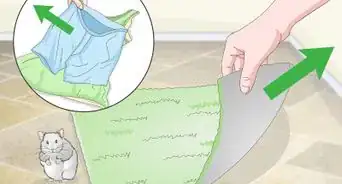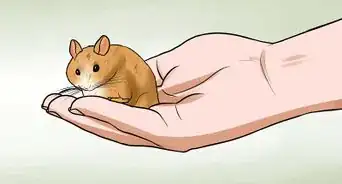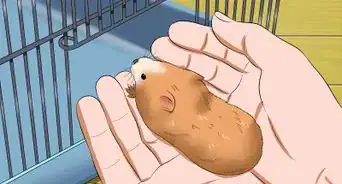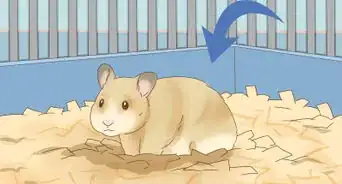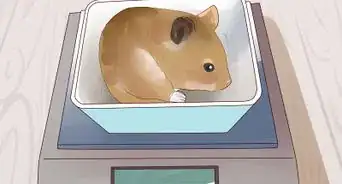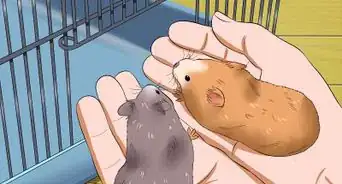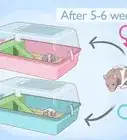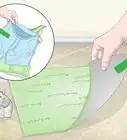This article was co-authored by Pippa Elliott, MRCVS. Dr. Elliott, BVMS, MRCVS is a veterinarian with over 30 years of experience in veterinary surgery and companion animal practice. She graduated from the University of Glasgow in 1987 with a degree in veterinary medicine and surgery. She has worked at the same animal clinic in her hometown for over 20 years.
wikiHow marks an article as reader-approved once it receives enough positive feedback. In this case, 87% of readers who voted found the article helpful, earning it our reader-approved status.
This article has been viewed 49,453 times.
You’ve just gotten a female hamster, or you accidentally allowed her to spend some quiet time with a gentleman caller. In any event, she’s unexpectedly become pear-shaped, as her abdomen swells with teeming baby hamsters. Or you were suddenly shocked to hear a chorus of tiny squeaks from your hamster’s enclosure. Either way, you don’t know what to do. You’re not the first to make this discovery, and best practices have been established to ensure both mother and pups are safe and secure.[1]
Steps
Keeping the Mother Calm
-
1Make the mother feel secure. Immediately following birth, mother hamsters need to feel secure. If she is startled by a loud noise or sudden light, she may become stressed and go into survival mode. For a mother hamster, this means cannibalizing her young. Accordingly, do everything you can to ensure calm and quiet atmosphere in the room where they live.[2]
- Keep other pets out of the room.
- Put the hamster enclosure against a wall and out of direct sunlight.
- Cover part of the enclosure with a blanket or cloth. The darkness this blanket provides will reduce stress.
-
2Add tissue or toilet paper. Throw some unscented tissue paper or toilet paper into the enclosure. Be sure not to surprise the mother hamster when doing so. She will shred up the paper and use it to increase the comfort and coziness of her nest. This is more important than you may realize. If the mother doesn’t feel like the environment is sufficient to raise pups, she’ll eat them.[3]
- Do not provide the artificial fluff sold for this purpose. Despite the marketing, these products can potentially injure your hamsters.
Advertisement -
3Minimize interaction for two weeks. If a mother hamster feels threatened by an unfamiliar scent, she will readily make a snack of her offspring. While it may seem as though there are a lot of reasons a mother hamster might go cannibalistic, they are all informed by the same sentiment. From a survival perspective, a protein rich diet of baby hamster flesh may give her the energy to escape whichever risk she has perceived. Accordingly, do not mess with her, her babies, or her cage for two weeks following the birth.[4]
- In particular, do not clean the cage. If you notice she is pregnant just before she gives birth, give the cage a good cleaning in preparation.
- Though it can be challenging, resist the temptation to handle the baby hamsters for two weeks. Touching all but guarantees that they’ll be eaten by their mother.
Helping Care for the Offspring
-
1Feed the mother well. Good nutrition is especially important for the mother following birth. You can probably guess why. Great protein options include finely chopped cooked eggs, plain boiled chicken, and tofu. Also feed her extra well chopped fruits and veggies, especially carrots and leafy greens. Wait to provide these foods until a few days after birth, unless she is low on food.[5]
- Take care not to spook her when adding food to her enclosure, and try to slowly place the food away from her and her babies.
- If you notice she is pregnant before she gives birth, stock the enclosure with a bunch of food that won’t go bad too quickly. This will include lots of hamster food as well as sunflower seeds.
- While you usually want to limit sunflower seed consumption, their fattiness is actually ideal for a mother hamster. Also fill up the water bottle all the way so you can avoid doing so for as long as possible once the babies arrive.
-
2Help feed the babies after a week. Do practically nothing for a week. After 7 or 8 days, the pups will first begin to move around their enclosure. At this point, they’ll also be able to nibble on solid food. Sprinkle well-chopped pieces of carrots, tofu, and leafy greens into their enclosure. They will enjoy discovering this food, and will also begin to eat from their mother’s dish.[6]
- At about 3 weeks of age, the babies will be weaned by their mother. This does not mean they should be taken from the enclosure, though they will no longer be nursing.
-
3Introduce yourself when they’re two weeks old. You can begin to handle baby hamsters when they open their eyes, at around 13 to 14 days old. Once all of the babies’ eyes are open, do a full cleaning of the cage as well. Don’t separate them permanently from their mother quite yet, as they still have plenty to learn.[7]
-
4Separate the babies when they’re 5 to 6 weeks old. This is the age that the hamsters will reach sexual maturity. You may keep young dwarf hamsters of the same sex together. All Syrian hamsters must be kept separately from one another. When they’re 6 to 8 weeks old, Syrian hamsters will begin to become territorial. They will soon be able to seriously injure one another, and will do so as soon as they are able.[8]
Deciding What to Do With the Babies
-
1Try to line up human owners early. Your litter may contain more than a dozen juvenile hamsters in search of a new home. It will likely prove challenging to find humans capable of housing each one, so start searching as soon as you find out about the babies. Ask your friends and family if they’re interested, and post the cutest photos you can get on every single social media platform you use.[9]
-
2Put them up for adoption. Websites such as adoptapet.com and craigslist.org are good spots to put a post about free baby hamsters. Petfinder.com also has a classified section that is quite popular. Do not try to profit from your hamsters – they are readily available.[10]
- At the same time, try to keep reptile owners from getting their hands on your hamsters. You can guess what they’ll do with them. Accordingly, charge a small “adoption” fee, such as $5. This is much cheaper than buying a hamster from a store, but will keep those who favor scaled creatures giving their own pets a free living lunch.
-
3Do not drop your baby hamsters off at a pet store. They don’t need them, and they don’t want them. They likely even have policies against accepting hamsters from unknown sources. This means that they won’t care for any hamsters that show up outside their door, thought they may feed them to the scaled animals they’re selling.[11]
- Try to avoid leaving hamsters at shelters as well. If you do, include a donation, as many shelters are not well-enough funded to care for hamsters.
References
- ↑ https://www.caringpets.org/how-to-take-care-of-a-hamster/raising-babies/
- ↑ http://hamsterhideout.com/forum/topic/61545-crash-course-on-accidental-pregnanciesbabies/
- ↑ http://hamsterhideout.com/forum/topic/61545-crash-course-on-accidental-pregnanciesbabies/
- ↑ https://www.caringpets.org/how-to-take-care-of-a-hamster/raising-babies/
- ↑ http://hamsterhideout.com/forum/topic/61545-crash-course-on-accidental-pregnanciesbabies/
- ↑ http://hamsterhideout.com/forum/topic/61545-crash-course-on-accidental-pregnanciesbabies/
- ↑ https://www.caringpets.org/how-to-take-care-of-a-hamster/raising-babies/
- ↑ http://hamsterhideout.com/forum/topic/61545-crash-course-on-accidental-pregnanciesbabies/
- ↑ https://www.caringpets.org/how-to-take-care-of-a-hamster/raising-babies/
About This Article
If your female hamster gives birth unexpectedly, do everything you can to keep a calm and quiet atmosphere in the room where they live. Remove any other pets or children from the room and cover the cage with a blanket to make the mother hamster relaxed. Without startling your hamster, carefully place some toilet paper or tissue into the cage for it to use to build a nest for the babies. Any disturbance or perceived threat might make the mother hamster eat the offspring, so leave the new family alone for at least two weeks, aside from delivering food. Give your hamster plenty of high protein food, like finely chopped cooked eggs, plain boiled chicken, and tofu, as well as finely chopped fruits and veggies, like carrots and leafy greens. For more tips from our Veterinary co-author, like how to help care for the baby hamsters, keep reading!
